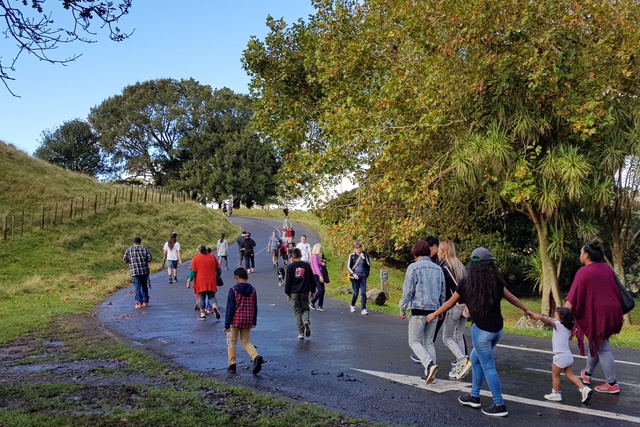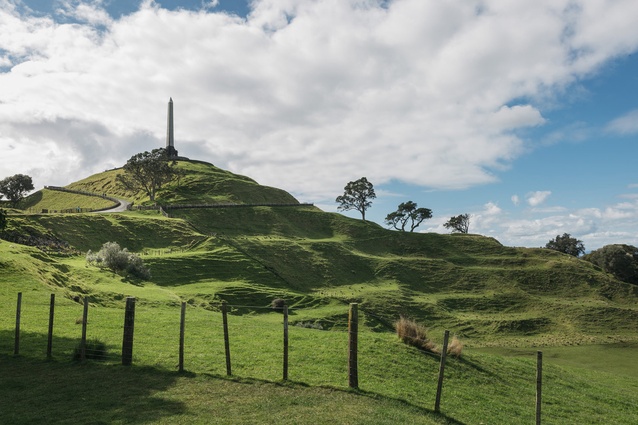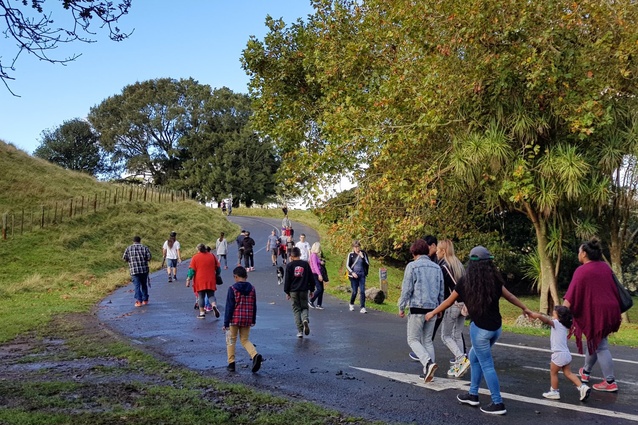A new era in maunga management
Mike George is the kaiwhakahaere whakapā hononga (communications and partnerships manager) for the Tūpuna Maunga Authority and the communications manager for the Co-Governance Unit at Auckland Council. In this article, he reflects on the fact that the Tūpuna Maunga (ancestral mountains), or volcanic cones, of Tāmaki Makaurau Auckland are on the cusp of a significant shift in how they are understood and respected.
Towering over the Auckland isthmus, the maunga (volcanic cones) have been adapted and used over many decades in many different ways, over time, shaping people’s connections to them and expectations of them. Throughout the twentieth century the maunga were treated in a utilitarian way that facilitated the fast-paced development of the country’s largest city.
The sides of many maunga were quarried away for aggregate, water reservoirs were sunk into their craters, roads were carved into their slopes and car parks were added on their summits, farming infrastructure and grazing stock were introduced, and exotic trees were planted. In modern times the maunga have been managed mostly as recreation parks, and today, this is how many people see them and value them.

But, there is a different history to the Auckland maunga – one so vital to our nation’s heritage, yet disregarded in the management and enhancement of these sites over the years. The largest and best known of Auckland’s maunga are in fact ancient pā, fortified village settlements, developed by early Māori following the first migrations to New Zealand around a thousand years ago.
The maunga enabled Tāmaki Makaurau to become an unparalleled centre of Māori social organisation, complex inter-tribal relationships and connections, transit and trade in Māori society at the time. They were places of settlement, agriculture, battles, marriages, birth and burial. To ngā Mana Whenua o Tāmaki Makaurau (the Māori tribes of Auckland), these sites are tūpuna maunga (ancestral mountains) and have held a paramount place in historical, spiritual, ancestral and cultural identity, unbroken over time.
The pits, terraces and middens are the last surviving remnants of the fortress settlements that once stood here. There are no obvious ancient built structures, which commonly provide that immediate visual cue of an archaeological site and an instant unquestioning respect for the heritage of the place by those who visit. Perhaps in some way, this contributed to the fast and complete transition of these historic sites to natural resources and parks, and the outlook that comes with this.
But all of that is changing. In 2014, 14 maunga were returned to 13 mana whenua iwi and hapū of Auckland in a landmark Treaty of Waitangi settlement, marking a turning point in the management and enhancement of these taonga. The settlement legislation allowed for the establishment of the Tūpuna Maunga Authority, a co-governance entity comprised of equal membership from ngā Mana Whenua o Tāmaki Makaurau and Auckland Council.
The Authority has adopted a unique management structure with a Māori world view at its heart; the health and well-being of the maunga is the decision-making paradigm and the wairua (life force) and mauri (spiritual essence) of the maunga are at the centre of all projects. The Authority has developed a Tūpuna Maunga Integrated Management Plan outlining the principles and values that all management and development decisions are tested against. The management plan, settlement details and list of maunga can be found at www.maunga.nz.
In just three years the Tūpuna Maunga Authority has already achieved significant milestones that contribute to restoring the authenticity and visual integrity of the maunga. Removing vehicle access to the tihi (summit) of Maungakiekie/One Tree Hill, Maungawhau/Mt Eden, Puketāpapa/Mt Roskill and Takarunga/Mt Victoria has recognised spiritual and cultural values and has had a markedly positive physical impact, too.
The visual imposition of cars driving across the maunga has vanished, along with related congestion and visitor health and safety issues, and the experience for pedestrians is greatly enhanced. Continued vehicle access for people with limited mobility is a necessary and important exception. Work to pedestrianise Ōwairaka/Mt Albert begins this year.

Vegetation management has started on some maunga with a focus on removing pest plants and exotic tree species and replacing them with natives in more appropriate locations. At Maungarei /Mt Wellington the Authority is in the process of removing 100-odd ageing pine trees and replacing them with 10,000 native trees and shrubs to create the largest expanse of native bush ecosystem in the Maungakiekie-Tāmaki Local Board area. Pest animals are being controlled and the Authority has had success with the complete eradication of rabbits from some maunga. There is also a plan to return native skinks and other indigenous invertebrates to re-established habitats.
Of course, the maunga remain public reserves and visitors are encouraged. The Authority is planning for improved visitor infrastructure that will cater to large numbers of people while also blending sympathetically into the landscape. Ground disturbance is avoided where possible to preserve the integrity of the whenua (land) and designers are asked to think outside the box to come up with low-Impact solutions.
The next large project will be comprehensive track and trail development – floating boardwalk concepts are being explored to protect sensitive archaeological features but also guide people past them, with interpretive signage to give visitors an in-depth understanding of where they are and what they are looking at. Creating an enjoyable destination that both protects and highlights the heritage of the maunga is key. These projects, paired with the new management values, will assist the maunga on the path towards UNESCO World Heritage status, something the Tūpuna Maunga Authority will be championing.
There is much work to be done, but the transition is well underway. Watch this space.
A version of this article was first published on the Landscape Architecture Aotearoa website, which is published by the New Zealand Institute of Landscape Architects (NZILA).












